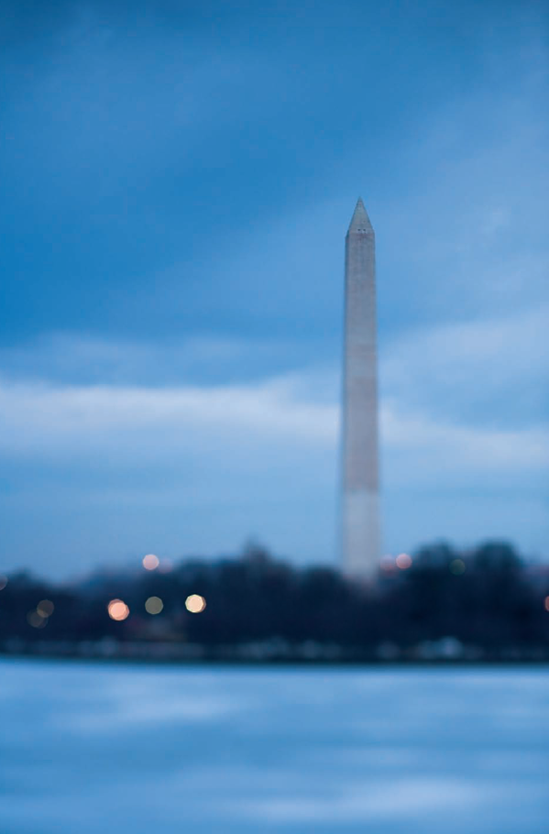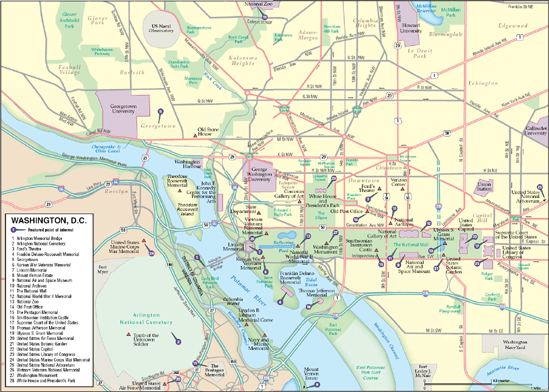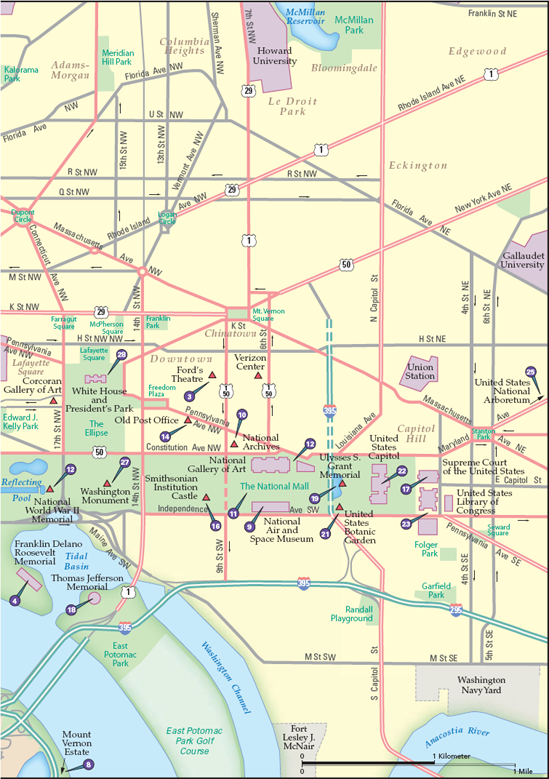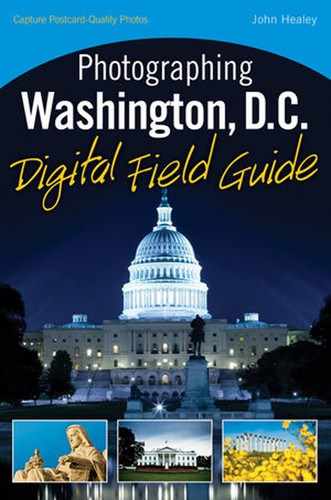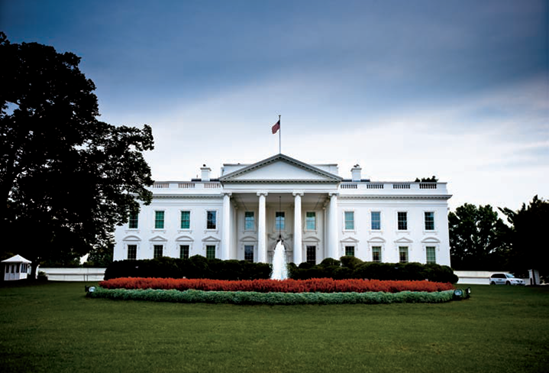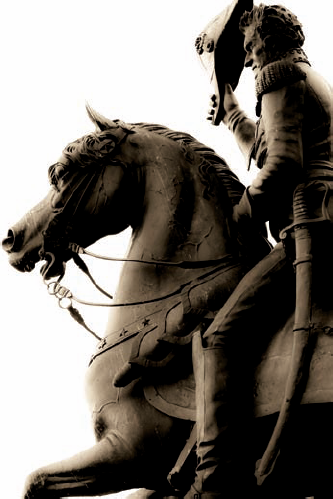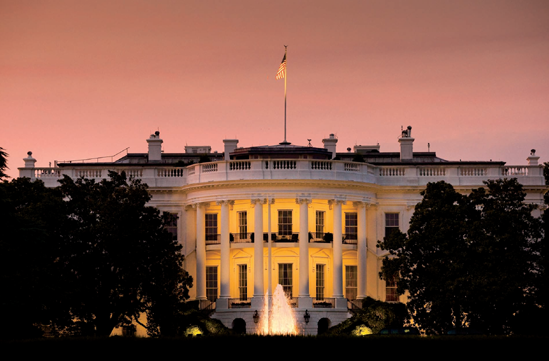
The White House from the south public viewing area off of E Street NW. Taken at ISO 1600, f/4, 1/80 second with a 160mm lens.
It's known as the most recognized address in the United States — 1600 Pennsylvania Avenue NW, Washington, D.C. The White House is the official residence and office of the President of the United States.
Following in the tradition of the White House being open to the public (it is the only private residence for a head of state in the world that is), tours of its interior are available to U.S. citizens by contacting their member of Congress. Non-U.S. citizens may arrange a tour through their embassy in Washington, D.C. However, essentially nothing is allowed to come with you after you enter the White House, including cameras.
President's Park encompasses the White House as well as the areas just around it: the White House Visitor's Center, Lafayette Park (to the north) and President's Park South, known as The Ellipse.
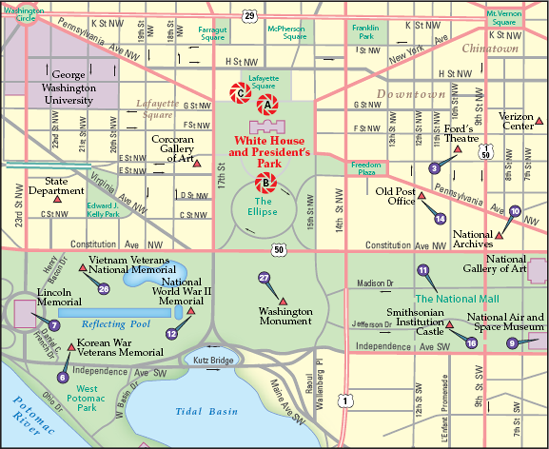
Figure 28.1. The best locations from which to photograph the White House and President's Park: (A) the sidewalk at 1600 Pennsylvania Avenue NW, (B) E Street NW, and (C) General Jackson statue in Lafayette Park. Nearby photo ops: (3) Ford's Theatre, (7) Lincoln Memorial, (9) National Air and Space Museum, (10) National Archives, (11) National Mall, (12) National World War II Memorial, (14) Old Post Office, (16) Smithsonian Institution Castle, (26) Vietnam Veterans National Memorial, and (27) Washington Monument.
The White House grounds are easily accessible on foot, and you can take pictures from either the north or south sides. Access to other views is limited. You have to photograph it through the metal fence that surrounds each side.
The north side along Pennsylvania Avenue is the closest view you can get of the White House. Although still a great view (see Figure 28.1), this side is less of an iconic view than the rounded South Portico. However, because of the wide-open sidewalk and the closed-to-traffic stretch of Pennsylvania Avenue, it can be less crowded and therefore easier to get a good view.
The South Portico is often seen when the press covers the President arriving or departing by helicopter, and when he and the first lady are greeting dignitaries. The vast south lawn gives the view here a more regal feel, as does the elegantly rounded portico (see Figure 28.2).
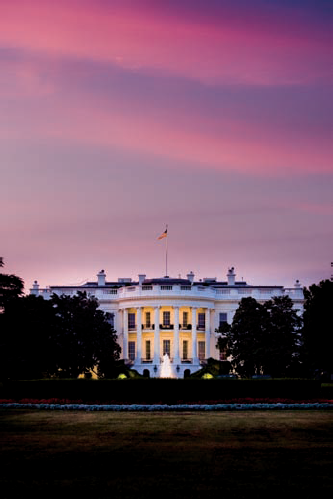
Figure 28.3. The White House seen from its south sidewalk off of E Street NW (see B on the map). Taken at ISO 800, f/4, 1/60 second with a 90mm lens.
It's also usually more crowded — there's less space because the sidewalk is narrower and because E Street NW is closed to both pedestrian and auto traffic. Like the north side, a metal fence blocks the view here, but you can position your camera between the bars to keep it out of the picture. The police may close either side at any time and at a moment's notice for any reason, although typically it is the south side that gets closed more often.
Just across from 1600 Pennsylvania Avenue NW is Lafayette Park, named for the first foreign guest to stay at the White House, General Marquis de Lafayette.
The General Jackson Statue (see Figure 28.3) shows Major General Andrew Jackson reviewing his troops at the Battle of New Orleans, Louisiana, in 1815. The 15-ton statue is made from the melted British cannons captured by Jackson at the historic battle.
Visiting the White House is the highlight of most visits to Washington, D.C. It's fairly easy to photograph well.
Photographing the White House doesn't require any special gear; in fact, most cameras with standard zoom lenses work well. It does help to have a more modern camera that has higher ISO settings while still maintaining quality for evening or dusk shots, but during the day most any camera will do well.
On the north side (refer to Figure 28.1), a 35mm lens works well when photographing from the metal gate. From the south side (refer to Figure 28.2), you'll be much farther away, which gives you more options for creativity. A lens of around 85mm is a good start. With it, you can capture some environment around the White House, including some sky.
Beginning at about 150mm, you can fill a horizontal frame with the White House from the south sidewalk. If you are photographing from the field farther south of E Street NW, you'll need a lens of over 200mm to fill the frame, and at that point the compression effect of a lens that long begins to make the White House look somewhat flat and lacking dimension.
Because the White House faces north and south, a polarizing filter can work well to enhance a blue sky and clouds. (A polarizer works best 90 degrees to the direction of the sun.) And either a graduated neutral density filter on your camera or within a software application can help even out the exposure of the sky. Be sure if you are choosing the software option to expose carefully, because you have less latitude for correction than you do when physically using a filter.
Tripods are not allowed on the sidewalks on either the north or south sides of the White House. On the north side, the police officers allow them to be used off the sidewalk on Pennsylvania Avenue, but there's not much point because you will most likely have the metal fence squarely in your shot. On the south side, officers generally allow their use on the sidewalk south of E Street NW and in the grass area here. You can get a cleaner photo here with a tripod than on the north side, but you'll just barely be over the heads of all the visitors (unless you want to compose them in your shot, which is another option).
If you wish to briefly use a tripod, it's recommended that you ask a nearby police officer by saying hello and explaining what you want to do — a little traditional courtesy can go a long way.
Note
See this book's Introduction for a more thorough look at Washington, D.C. dos and don'ts for tripods.
Using Shutter Priority or Aperture Priority on your camera should get good results here, assuming that the building and sky are roughly at the same exposure (such as during midday). If it is early morning or late evening, you can avoid camera shake by using shutter-speed priority and setting it at 1/60 second, although you can try to go as low as 1/15 or 1/10 if you are careful to hold your camera very still. Because you'll be photographing through the bars of the gate surrounding the White House, you can rest your camera against these bars and use a much slower shutter speed than by just handholding your camera.
Notice that in Figure 28.2, the standard shutter speed rule of one over your focal length was broken: The shot was made with a 90mm lens at a shutter speed of 1/60 second. Normally, you would want to keep your camera set at 1/125 in a situation like that to avoid camera shake. But because the bars allow you to rest your camera against them and effectively stabilize the lens, you can slow down your shutter speed. If you have a newer, high-end camera that has ISO speeds higher than 3200, you don't necessarily need to concern yourself with this.
You can get a good photo of the White House at most any time. Of course, having nice light never hurts a photo.
The White House, perhaps because it is inherently beautiful and because it is facing north-south, can be photographed at almost any time during the day and make a nice photograph. (Buildings that face east-west are inherently more problematic because of the sun being either directly behind or in front of them.)
However, as shown in the example photos, a colorful sky never hurts a photo. If you plan on visiting during the setting sun and are careful to hold your camera steady, you can get lovely images with colorful skies and the White House subtly lit without direct sunlight (refer to Figure 28.2).
A day of adverse weather could actually be great when photographing here because of the uniqueness of the photograph that you'll get. Whether it is snow, fog, or a brewing storm overhead, don't avoid taking a photo here if the weather is less than perfect. Rain may make the shot problematic, however. If rain begins to pour, you can take refuge in the nearby White House Visitor Center.
Nighttime is a tough time to photograph the White House. Using tripods in the good spots isn't allowed, so you have to use a high ISO because you'll be handholding your camera (even with it stabilized against the bars of the gate surrounding it). The most recent high-end digital cameras have ISO settings that are enabling photographers to shoot at ISO 3200 and well beyond. If you have one of these, the White House at dusk and night is a great use for it.
Most cameras' automatic modes will expose a night scene here reasonably well. If you want to try the more advanced way of using your camera's manual exposure settings, do what a professional would do if faced with a similar situation and no tripod — start shooting at an exposure that you feel you can reasonably handhold, such as 1/30 second at f/4 at an ISO of 1600.
Take a few shots and then slow down your shutter speed (you'll have to use Shutter-Speed Priority mode in combination with exposure compensation, or Manual mode), taking a few shots each time. Slow down your shutter speed to something that isn't routinely hand-holdable, such as 1/10 second or slower, and shoot several frames while stabilizing your camera against the bars of the gate as you do.
Changing your shutter speed only on an automatic mode, such as Shutter Priority, won't change the overall exposure. Of course, for newer cameras that have very good quality high ISO settings, such techniques are becoming less and less necessary.
Even though you would be holding your camera well below what the typical shutter speed guidelines suggest, it doesn't hurt to try. The goal is that you get one or two frames that are well-exposed and tack sharp using settings that are a little harder to hand hold, while you have a few with more "safe" settings as a backup. You could also set a lower ISO if you are getting good results to enhance the quality of your photo.
Because you are limited on locations to shoot from, there are fewer possibilities for compositional creativity. But still, you can shoot with wide or long lenses to create something different. Also, the crowds that are attracted here can be enormous, and that alone can be worthy of an alternative to the standard White House photo. And if you are lucky, you may able to watch the President land or take off in Marine One from the White House's South Lawn.
